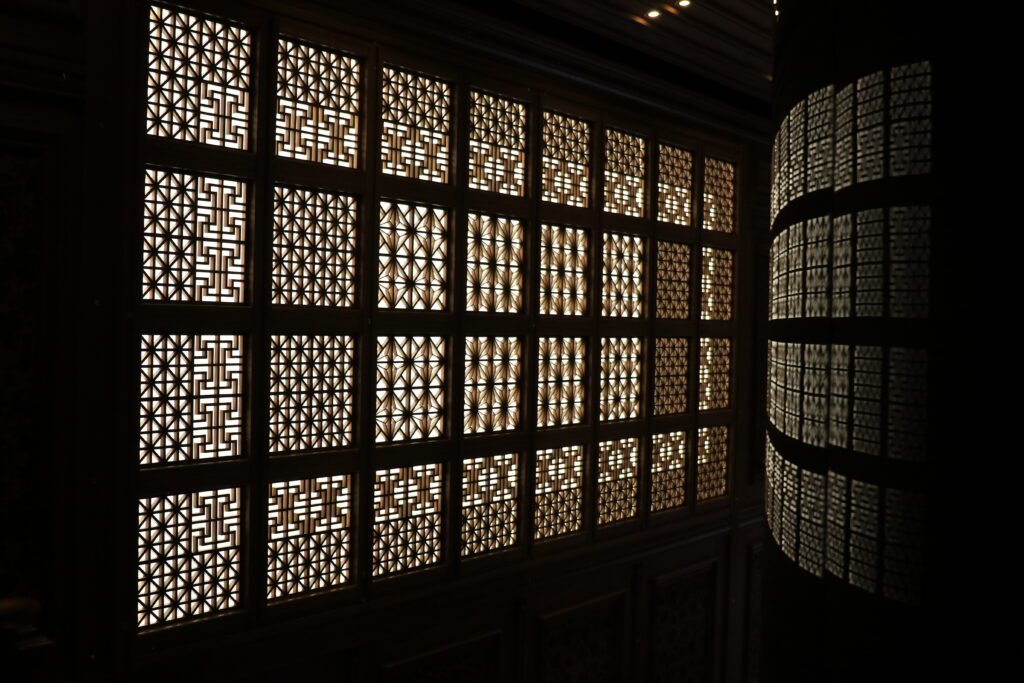Kumiko patterns—intricate wooden latticework joined without nails—represent a pinnacle of Japanese craftsmanship that has captivated woodworkers and design enthusiasts for centuries. After publishing a simple introduction to these patterns, I was surprised by the enthusiastic response, which inspired me to create a comprehensive guide exploring 40 distinctive Kumiko patterns and their symbolic meanings.
This article presents an overview of these patterns, organized into four categories that will form the basis of an upcoming series. By understanding these traditional designs and their cultural significance, we can appreciate why Kumiko continues to inspire both traditional craftspeople and contemporary designers worldwide.
Special Feature Schedule
- Part 1: Hemp Leaf Kumiko Pattern
- Part 2: Diamond and Lattice Kumiko Pattern
- Part 3: Tortoise Shell and Basketweave Kumiko Pattern
- Part 4: Distinctive Motifs and Combination Kumiko Pattern
The Four Categories of Traditional Japanese Kumiko Patterns
1. Hemp Leaf Patterns: Elegant Geometric Designs Inspired by Natural Hemp Leaves
Hemp leaf patterns (asa-no-ha) feature geometric shapes radiating from central points, inspired by the cannabis plant’s distinctive foliage. In Japanese culture, hemp symbolizes robust growth and purification, with parents traditionally dressing infants in hemp-patterned clothing to ensure healthy development.
Notable patterns include:
- Asa-no-ha (Basic Hemp Leaf)
- Tsuno-asa-no-ha (Horned Hemp Leaf)
- Shippo-asa-no-ha (Seven Treasures Hemp Leaf)
- Yae-asa (Multilayered Hemp Leaf)
- Futae-asa-no-ha (Double Hemp Leaf)
- Kawari-asa-no-ha (Modified Hemp Leaf)
- Kikyō-asa-no-ha (Bellflower Hemp Leaf)
- Kaku-asa (Angular Hemp Leaf)
- Kiri-asa-no-ha (Paulownia Hemp Leaf)
For readers seeking comprehensive information about specific Kumiko patterns, the following article in the series provides detailed explorations of individual designs within that category.
2. Diamond and Lattice Patterns: Geometric Designs Based on Diamond Shapes and Grid Structures
These patterns emphasize mathematical precision through diamond shapes and grid arrangements, embodying order, harmony, and protection.
Key examples include:
- Hishi (Diamond) – Symbolizing life’s resilience
- Futae-hishi (Double Diamond) – Representing reinforced prosperity
- Mie-hishi (Triple Diamond) – Expressing completeness
- Izutsu-hishi (Well Frame Diamond) – Suggesting life’s sustenance
- Senbon-kōshi (Thousand-Bar Lattice) – Creating rhythmic visual effects
- Hishi-san-no-ji-kuzushi (Modified Diamond Three-Character)
- Tsuzuki-izutsu (Connected Well Frames)
- Komochi-hishi (Child-Bearing Diamond)
- Masu-kōshi (Square Lattice)
- Nawame (Rope Pattern)
For readers seeking comprehensive information about specific Kumiko patterns, the following article in the series provides detailed explorations of individual designs within that category.
3. Tortoise Shell and Basketweave Patterns: Designs Characterized by Hexagonal Forms and Mesh Structures
These patterns feature hexagonal or circular arrangements symbolizing longevity, protection, and interconnectedness.
Significant patterns include:
- Kagome (Basketweave) – Offering spiritual protection
- Benten-kikko (Benten Tortoise Shell) – Merging longevity with artistic blessing
- Yae-kagome (Multilayered Basketweave)
- Bishamon-kikko (Bishamon Tortoise Shell)
- Kawari-urabana-kikko (Modified Reverse Flower Tortoise Shell)
- Tsumiishi-kikko (Stacked Stone Tortoise Shell)
- Shippo (Seven Treasures)
- Yae-urabana (Multilayered Reverse Flower)
- Sayagata-kuzushi (Modified Sayagata)
- Shokko (Chinese Brocade Pattern)
For readers seeking comprehensive information about specific Kumiko patterns, the following article in the series provides detailed explorations of individual designs within that category.
4. Distinctive Motifs and Combination Patterns: Designs Featuring Specific Motifs or Complex Combinations
This category includes patterns derived from specific natural elements, cultural symbols, or innovative combinations that showcase individual artisan creativity.
Notable examples:
- Mitsugumite (Three-Way Joint) – Demonstrating core Kumiko joinery techniques
- Kasane-rindo (Layered Gentian) – Reflecting aristocratic refinement
- Rindo (Gentian) – Symbolizing sincerity and health
- Goma (Sesame) – Representing longevity
- Kawari-goma (Modified Sesame)
- Ura-goma (Reverse Sesame)
- Sakura (Cherry Blossom) – Embodying transience and renewal
- Mikado-tsunagi (Imperial Connection)
- Seigaiha (Blue Ocean Waves) – Suggesting eternal prosperity
- Masu-tsunagi (Connected Squares)
- Fundo-wa-tsunagi (Weight-Ring Connection)
For readers seeking comprehensive information about specific Kumiko patterns, the following article in the series provides detailed explorations of individual designs within that category.
Looking Ahead: Exploring Kumiko’s Cultural Depth
In our upcoming series, we’ll examine each category in detail, revealing the historical context, symbolic significance, and contemporary applications of these remarkable patterns. From ancient aristocratic tastes to modern sustainability principles, Kumiko patterns create a bridge between traditional craftsmanship and innovative design.
These patterns aren’t merely decorative—they embody philosophical concepts about nature, harmony, and human aspiration. Whether incorporated into traditional Japanese architecture or contemporary global design, Kumiko patterns continue to evolve while maintaining their essential character and cultural resonance.
Our first installment will focus on Hemp Leaf patterns, exploring how this simple botanical form evolved into one of Japan’s most enduring design motifs, carrying wishes for healthy growth and prosperity through generations. We invite you to join us in discovering the beauty, precision, and profound symbolism woven into the wooden lattice art of Kumiko.

“Kumiko Patterns: Tradition and Symbolism” Series
This “Kumiko Patterns: Tradition and Symbolism” series will be published in four consecutive installments. If you’re intrigued by these traditional Japanese wooden lattice designs and their cultural meanings, we invite you to explore each article through the links below as they become available. Each installment delves deeply into one category, revealing the historical context, symbolic significance, and contemporary applications of these remarkable patterns.
- Kumiko Patterns: Tradition and Symbolism Part.1 – The Sacred Geometry of Hemp Leaf Designs
- Kumiko Patterns: Tradition and Symbolism Part.2 – Diamond and Lattice Structures
- Kumiko Patterns: Tradition and Symbolism Part.3 – Tortoise Shell and Basketweave Artistry
- Kumiko Patterns: Tradition and Symbolism Part.4 – Distinctive Motifs and Combination Masterpieces
Thank you 🙂



